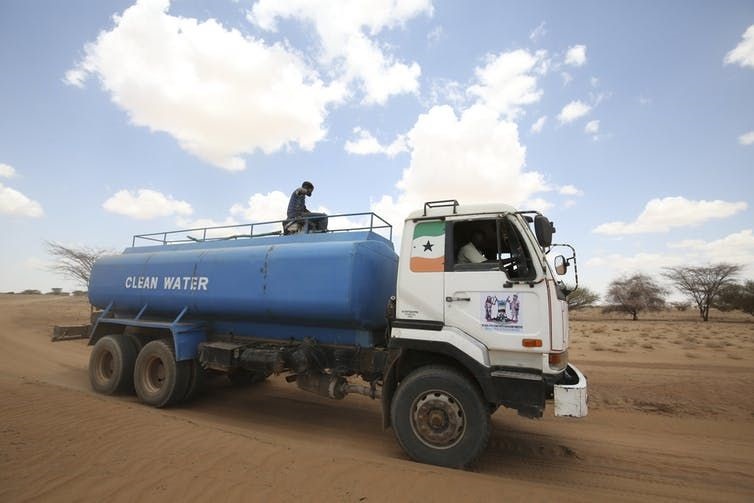How Kenya's pastoralists are coping with changes in weather patterns

In Kenya over 13 million pastoralists and agro-pastoralists rely on livestock, and they live in the arid and semi-arid lands of Kenya.
The changes in weather patterns have made life a great deal more precarious for these communities. Rainfall changes have resulted in floods and increasingly scarce, scattered and unpredictable pastures. Animals have become weaker because they have to walk further in search of food. Livestock have also died or become ill due to heat stress or colder seasons.
My colleagues and I conducted research into the strategies used by pastoralist communities in northern Kenya to manage these changes.
In interviews and data collected from 350 households we were able to establish what they’re doing to adapt. Steps they’ve taken include investing in livestock that are more drought resilient, such as camels. They have also sought out new pastures and water ahead of an anticipated drought. Others have chosen to diversify their livelihoods by taking informal work when they can.
Our findings give some reassurance in terms of how dynamic these communities can be in adapting to climate change. The information we’ve gathered should also be used to inform Kenya’s national policies on climate change adaptation strategies in pastoral areas in arid and semi-arid areas of the country.
But these strategies don’t always work and pastoralists aren’t able to cope with the fluctuations in climate. Relief supplies – like food, shelter materials and medicines – from aid agencies and the county government are an important source of livelihood to some vulnerable households, even in non-drought seasons. This is because there are households that have become destitute due to the impact of dramatic weather events and have not been able to recover.
Survival strategies
About 98.6% of the respondents in the study area indicated that they had seen changes in the climate over the years. Most (63.5%) attributed this to God and that this was a punishment in response to man’s disobedience to Gods ways.
All respondents said that their livestock had been affected as a result of these changes, with the animal’s poor body condition listed as the greatest impact. And so they’ve adopted a range of strategies.
Pastoralists are changing what animals eat. From grazing on natural pasture, livestock is increasingly being fed on purchased or harvested fodder, crop residue and commercial feeds.
They’re also investing more in water tankers for water supply. Traditionally pastoral households water their cattle, sheep and goats after every two days and camels after five days during periods of water stress. But traditional water sources – like seasonal rivers and wells – have dried up. This has left just the Tana river as the main source of water throughout the year. Water tankers can help to preserve the breeding stock of animals as these can help pastoralists to recover numbers after the drought.
To cover the additional expenses of fodder or water, pastoral households use strong social networks to pull resources together. This is also because livestock from various households migrate and also graze together.
Pastoralists are also diversifying their herd species. For example, the Somali Abdalla clan in Kenya now embraces camel production, as opposed to cattle goats and sheep, which used to be a cultural taboo. Camels are more resilient, for instance, they don’t need to be watered so often, to climate risks than other livestock species.
Livestock off-take – selling livestock – is another strategy. The growing market for livestock, locally and in Middle Eastern countries – like Yemen and Saudi Arabia – has supported this. However, during drought periods they offer low prices (about 60% lower than the average prices) which means that households could incur losses if they reinvest the funds in restocking after a drought.
To reduce their dependence on livestock, households are diversifying their incomes. For instance, small-scale irrigated crop agriculture is expanding fast along the Tana river.
They’re also developing businesses – including the sale of livestock and livestock products like milk, meat, hides and skins. Most businesses are low scale and the returns are mainly used for daily households needs.
In some cases, households have to engage in environmentally destructive livelihoods like charcoal burning.
Remittances from family members are becoming a major source of income. This is against a backdrop of a young generation that are not keen to live as pastoralists and dwindling livestock numbers per household. Remittances also allow households to take more risks – like reinvesting some money into buying livestock and investing in small scale irrigated agriculture – since they have a safety net.
It’s imperative that these adaptation strategies are recognised and that pastoralist communities are supported in them.
This article is republished from The Conversation under a Creative Commons license. Read the original article.
Source: The Conversation Africa

The Conversation Africa is an independent source of news and views from the academic and research community. Its aim is to promote better understanding of current affairs and complex issues, and allow for a better quality of public discourse and conversation.
Go to: https://theconversation.com/africa


